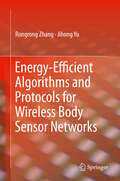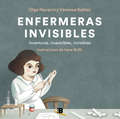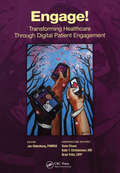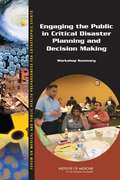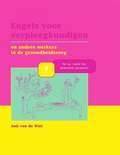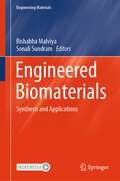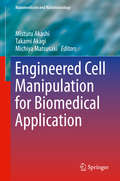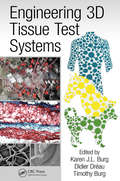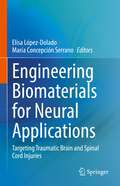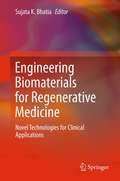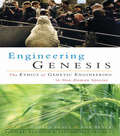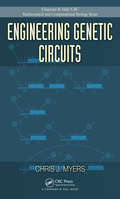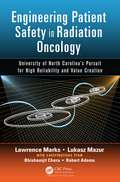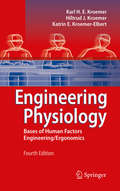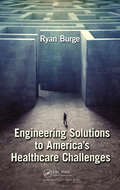- Table View
- List View
Energy-Efficient Algorithms and Protocols for Wireless Body Sensor Networks
by Jihong Yu Rongrong ZhangThis book provides a systematic treatment of the theoretical foundation and algorithmic tools necessary in the design of energy-efficient algorithms and protocols in wireless body sensor networks (WBSNs). These problems addressed in the book are of both fundamental and practical importance. Specifically, the book delivers a comprehensive treatment on the following problems ranging from theoretical modeling and analysis, to practical algorithm design and optimization: energy-efficient clustering-based leader election algorithms in WBSNs; MAC protocol for duty-cycling WBSNs with concurrent traffic; multi-channel broadcast algorithms in duty-cycling WBSNs; and energy-efficient sleep scheduling algorithms in WBSNs. Target readers of the book are researchers and advanced-level engineering students interested in acquiring in-depth knowledge on the topic and on WBSNs and their applications, both from theoretical and engineering perspective.
Enfermeras invisibles
by Vanessa Ibáñez Olga Navarro Irene Bofill¿Quién fue la enfermera que salvó la vida de dos mil quinientos niños y niñas judíos del gueto de Varsovia? ¿Cuál es la historia de la mujer que inventó y patentó la jeringa que se puede utilizar con una sola mano? ¿O la que diseñó el portabebés y la mochila de oxígeno portátil? ¿Conoces la historia de la mujer que encabezó la primera campaña mundial de vacunación? Trepidantes aventuras de viajes y peligros, relatos de superación y grandes descubrimientos científicos es lo que vas a encontrar en la vida de estas catorce mujeres valientes e invisibles que dieron todo por los demás haciendo lo que mejor sabían, cuidar. Escrito por dos enfermeras después de una ardua investigación, este libro ilustrado es un homenaje a una profesión que merece ocupar un lugar predominante en la historia.
Enforcing Normalcy: Disability, Deafness, and the Body
by Lennard J. DavisThis book tries to think through some of the complex issues raised by concepts such as the body, the normal, the abnormal, disability, the disabled, and people with disabilities. I wrote this book because I believe deeply that people with disabilities, Deaf people, and others who might not even consider themselves as having a disability have been relegated to the margins by the very people who have celebrated and championed the emergence of multiculturalism, class consciousness, feminism, and queer studies from the margins.
Engage!: Transforming Healthcare Through Digital Patient Engagement (HIMSS Book Series)
by Jan Oldenburg Dave Chase Kate T. Christensen Brad TritleThis book explores the benefits of digital patient engagement, from the perspectives of physicians, providers, and others in the healthcare system, and discusses what is working well in this new, digitally-empowered collaborative environment. Chapters present the changing landscape of patient engagement, starting with the impact of new payment models and Meaningful Use requirements, and the effects of patient engagement on patient safety, quality and outcomes, effective communications, and self-service transactions. The book explores social media and mobile as tools, presents guidance on privacy and security challenges, and provides helpful advice on how providers can get started. Vignettes and 23 case studies showcase the impact of patient engagement from a wide variety of settings, from large providers to small practices, and traditional medical clinics to eTherapy practices.
Engaged to the Doctor Sheikh
by Meredith WebberExile or marriage, the choice is hers... Sheikh Tariq al Askeba knows Lila Halliday is trouble... From the moment the Australian pediatric doctor arrives wearing an ancient amulet stolen from his family years before, scandal precedes her. Lila is stunned to discover the sordid history of her birth mother's pendant. She came to Karuba to discover her true heritage, not set the whole palace in uproar!Knowing there's no other way to quell the upheaval, Tariq gives her a shocking ultimatum: leave...or become his desert bride!
Engagement and Therapeutic Communication in Mental Health Nursing (Transforming Nursing Practice)
by Sandra WalkerBeing able to engage with service users and communicate effectively is a fundamental skill identified by the NMC and required of all mental health nurses. The reality is that building rapport and developing therapeutic relationships does not come instinctively for everyone. The authors have responded to this with a book that explains the different communication theories and models and goes on to show students how they work in the real world. Innovative exercises encourage reflection and enable students to practice their developing communication skills as they progress. Throughout the book the authors are focussed on promoting recovery and have put the service user at the centre of the discussion, ensuring that their voice is heard. Key features: - Covers the communication content of the new NMC Standards and Essential Skills Clusters for pre-registration degree-level nursing education - Focussed on promoting recovery and adopts a person-centred approach - Interactive style using realistic scenarios and case studies making theory easy to apply to practice - Includes a chapter co-authored by a service user offering a unique insight.
Engaging the Public in Critical Disaster Planning and Decision Making
by Institute of Medicine Board on Health Sciences Policy Forum on Medical and Public Health Preparedness for Catastrophic Events Theresa Wizemann Bruce Altevogt Megan ReeveEngaging the Public in Critical Disaster Planning and Decision Making is the summary of a workshop held in March 2013 to discuss the key principles of public engagement during the development of disaster plans, the response phase, and during the dissemination phase when interested community partners and the general public are informed of the policies that have been adopted. Presenters provided specific examples of resources to assist jurisdictions in planning public engagement activities as well as challenges experienced and potential solutions. This report introduces key principles of public engagement, provides practical guidance on how to plan and implement a public engagement activity, and presents tools to facilitate planning.
Engaging with Climate Change: Psychoanalytic and Interdisciplinary Perspectives (The New Library of Psychoanalysis 'Beyond the Couch' Series)
by Sally WeintrobeHow can we help and support people to face climate change? Engaging with Climate Change is one of the first books to explore in depth what climate change actually means to people. It brings members of a wide range of different disciplines in the social sciences together in discussion and to introduce a psychoanalytic perspective. The important insights that result have real implications for policy, particularly with regard to how to relate to people when discussing the issue. Topics covered include: what lies beneath the current widespread denial of climate change how do we manage our feelings about climate change our great difficulty in acknowledging our true dependence on nature our conflicting identifications the effects of living within cultures that have perverse aspects the need to mourn before we can engage in a positive way with the new conditions we find ourselves in. Through understanding these issues and adopting policies that recognise their implications humanity can hope to develop a response to climate change of the nature and scale necessary. Aimed at the general reader as well as psychoanalysts, psychotherapists and climate scientists, this book will deepen our understanding of the human response to climate change.
Engineered Antimicrobial Surfaces (Materials Horizons: From Nature to Nanomaterials)
by Sabu Thomas Nandakumar Kalarikkal S. Snigdha E. K. RadhakrishnanThis volume looks at the different aspects involved in controlling microbial growth and the techniques employed in obtaining sterile surfaces. It covers research on coatings, nano-materials, herbal materials, naturally occurring antimicrobials in designing antimicrobial surfaces. It discusses issues of antibiotic resistance, synthesis techniques, toxicity, and current and potential applications of antimicrobial surfaces, and this book will serve as a useful reference to a broad range of scientists, industrial practitioners, graduate and undergraduate students, and other professionals in the fields of polymer science and engineering, materials science, surface science, bioengineering and chemical engineering.
Engineered Biomaterials: Synthesis and Applications (Engineering Materials)
by Rishabha Malviya Sonali SundramThis book highlights recent advances focusing on the synthesis methods of engineered biomaterials and their applications. The book discusses recent applications of various approaches and technology in improving the functional properties and biological activities of biopolymers. It includes two major sections: the first section introduces a range of methods which lead to materials with enhanced properties for a range of practical applications, along with the positives and limitations of the techniques. The second section covers recent trends and advances in application of engineered biomaterials that assist materials scientists and researchers in mapping out the future of these new improved materials through value addition in order to enhance their use. Contributions in the book are done by prominent researchers from industry, academia, and government/private research laboratories across the globe. The book summarizes in a fairly comprehensive manner many of the recent technical advancements in the area of biopolymers. The book is intended to serve as a reference resource in the area of polymers science.
Engineered Cell Manipulation for Biomedical Application
by Misturu Akashi Takami Akagi Michiya MatsusakiThis book is the first to summarize new technologies for engineered cell manipulation. The contents focus on control of cellular functions by nanomaterials and control of three-dimensional cell-cell interactions. Control of cellular functions is important for cell differentiation, maturation, and activation, which generally are controlled by the addition of soluble cytokines or growth factors into cell culture dishes. Target antigen molecules can be efficiently delivered to the cytosol of the dendritic cells using the nanoparticle technique described here, and cellular functions such as dendritic cell maturation can be controlled easily and with precision. This book describes basic preparation of the nanoparticles, activation control of dendritic cells, immune function control, and in vivo application for various vaccination systems. The second type of control,that of cell-cell interaction, is important for tissue engineering in order to develop three-dimensional cellular constructs. To achieve in vitro engineering of three-dimensional human tissue constructs, cell-cell interaction must be controlled in three dimensions, but typical biological cell manipulation technique cannot accomplish this task. An engineered cell manipulation technique is necessary. In this book the authors describe the fabrication of nanofilms onto cell surfaces, development of three-dimensional cellular multilayers, and various applications of the cellular multilayers as three-dimensional human models. This important work will be highly informative for researchers and students in the fields of materials science, polymer science, biomaterials, medicinal science, nanotechnology, biotechnology, and biology.
Engineering 3D Tissue Test Systems
by Karen J. L. Burg, Didier Dréau and Timothy BurgEngineering 3D Tissue Test Systems provides an introduction to, and unique coverage of, a rapidly evolving area in biomaterials engineering. It reveals the current and future research responses, the current and future diagnostic applications, and provides a comprehensive overview to foster innovation. It offers insight into the importance of 3D systems and their use as benchtop models, spanning applications from basic scientific research to clinical diagnostics. Methods and limitations of building 3D tissue structures are evaluated, with attention given to the cellular, polymeric, and fabrication instrumentation components. The book covers the important aspects of polymeric tissue test systems, highlighting the needs and constraints of the industry, and includes a chapter on regulatory and pricing issues.
Engineering Biomaterials for Neural Applications
by Elizabeth NanceThis contributed volume explores the ways in which researchers engineer new biomaterials for the challenging problems of the peripheral and central nervous systems. These biomaterials are uniquely positioned for use in creating in vitro models of injury and disease, testing therapeutic treatments, understanding neural development, and mapping the multi-scalar environment of the brain. This book informs readers from biology, chemistry, materials science, engineering, and neuroscience on cutting edge research in engineering technologies, from fundamental material development through pre-clinical studies. The book also highlights target applications in three areas of research: (1) engineering neural models and materials, (2) probing biological underpinnings of neurological function and disease, and (3) designing therapeutic and diagnostic treatments for neurological disease.
Engineering Biomaterials for Neural Applications: Targeting Traumatic Brain and Spinal Cord Injuries
by Elisa López-Dolado María Concepción SerranoThis book describes past and present advances in engineering materials for neural applications, with special emphasis on their usefulness for traumatic brain and spinal cord injuries. The book presents major physio-pathological features of traumatic injuries at the brain and spinal cord as examples of diseases hampering the central nervous tissue. By incorporating knowledge from the perspective of experts with diverse backgrounds, this book gives insight into the understanding of these multifaceted pathologies and the materials science approaches that aim to cure them. The interdisciplinary nature of this book makes it a perfect candidate for the interest of a broad audience, from clinicians working on neural diseases to scientists whose work focuses on the nervous tissue (neuroscientists) and/or materials science. Undergraduate and PhD students can also benefit from the knowledge and discussion included in this book.
Engineering Biomaterials for Regenerative Medicine
by Sujata K. BhatiaRegeneration of tissues and organs remains one of the great challenges of clinical medicine, and physicians are constantly seeking better methods for tissue repair and replacement. Tissue engineering and regenerative medicine have been investigated for virtually every organ system in the human body, and progress is made possible by advances in materials science, polymer chemistry, and molecular biology. This book reviews the current status of biomaterials for regenerative medicine, and highlights advances in both basic science and clinical practice. The latest methods for regulating the biological and chemical composition of biomaterials are described, together with techniques for modulating mechanical properties of engineered constructs. Contributors delineate methods for guiding the host response to implantable materials, and explain the use of biologically-inspired materials for optimal biological functionality and compatibility. The book culminates in a discussion of the clinical applications of regenerative medicine. By integrating engineering and clinical medicine, Engineering Biomaterials for Regenerative Medicine examines how tissue engineering and regenerative medicine can be translated into successful therapies to bridge the gap between laboratory and clinic. The book will aid materials scientists and engineers in identifying research priorities to fulfill clinical needs, and will also enable physicians to understand novel biomaterials that are emerging in the clinic. This integrated approach also gives engineering students a sense of the excitement and relevance of materials science in the development of novel therapeutic strategies.
Engineering Genesis: Ethics of Genetic Engineering in Non-human Species
by Donald Ann BruceFew issues have aroused so much public attention and controversy as recent developments in biotechnology. How can we make sound judgements of the cloning of Dolly the sheep, genetically altered foodstuffs, or the prospect of transplanting pigs' hearts into humans? Are we 'playing God' with nature? What is driving these developments, and how can they be made more accountable to the public? Engineering Genesis provides a uniquely informed, balanced and varied insight into these and many other key issues from a working group of distinguished experts - in genetics, agriculture, animal welfare, ethics, theology, sociology and risk - brought together by the Society, Religion and Technology Project of the Church of Scotland. A number of case studies present all the main innovations: animal cloning, pharmaceutical production from animals, cross-species transplants, and, genetically modified foods. From these the authors develop a careful analysis of the ethical and social implications - offering contrasting perspectives and insightful arguments which, above all, will enable readers to form their own judgements on these vital questions.
Engineering Genetic Circuits (Chapman & Hall/CRC Computational Biology Series)
by Chris J. MyersThis text presents the modeling, analysis, and design methods for systems biology. It discusses how to examine experimental data to learn about mathematical models, develop efficient abstraction and simulation methods to analyze these models, and use analytical methods to design new circuits. The author reviews basic molecular biology and biochemistry principles, covers several methods for modeling and analyzing genetic circuits, and uses phage lambda as an example throughout to help illustrate the methods. He also explores the emerging area of synthetic biology. iBioSim software, lecture slides, and a password-protected solutions manual are available on the author's website.
Engineering Methodologies for Medicine and Sports: Proceedings of EMMS 2024 (Mechanisms and Machine Science #162)
by Roberto Montanari Maria Richetta Massimiliano Febbi Enrico Maria StaderiniThis book presents the proceedings of the International Workshop on Engineering Methodologies for Medicine and Sports (EMMS), held in Rome, Italy on February 7-9, 2024. It includes peer-reviewed papers on emerging engineering methodologies applied to biomedicine and sports, discussing topics such as advanced biomaterials, biodegradable implants, additive manufacturing of prosthesis, surface design, fabrication of bioreactors, design of biomechanical devices, rehabilitation and prevention, AI applications to medicine, biosensors, medical signal analysis, medical sensors, detection and monitoring of substances dangerous for health, biomechanics, assessment of sport performance, sport activity as a diagnostic device. A valuable, up-to-date resource, it offers an essential overview of the subject for scientists and practitioners alike, and will inspire further investigations and research.
Engineering Natural Product Biosynthesis: Methods and Protocols (Methods in Molecular Biology #2489)
by Elizabeth SkellamThis volume highlights natural products, molecular methods for identifying, and current trends in designing non-natural natural products. Chapters guide readers through protocols on heterologous expression techniques, gene disruption, modified pathway regulators, and in-vitro studies. Written in the format of the highly successful Methods in Molecular Biology series, each chapter includes an introduction to the topic, lists necessary materials and reagents, includes tips on troubleshooting and known pitfalls, and step-by-step, readily reproducible protocols. Authoritative and cutting-edge, Engineering Natural Product Biosynthesis: Methods and Protocols aims to be a useful and practical guide to new researchers and experts looking to expand their knowledge. Chapter 13 is available open access under a Creative Commons Attribution 4.0 International License via link.springer.com.
Engineering Open-Source Medical Devices: A Reliable Approach for Safe, Sustainable and Accessible Healthcare
by Andrés Díaz Lantada Arti Ahluwalia Carmelo De MariaThis book focuses on the challenges and potentials of open source and collaborative design approaches and strategies in the biomedical field. It provides a comprehensive set of good practices and methods for making these safe, innovative and certifiable biomedical devices reach patients and provide successful solutions to healthcare issues. The chapters are sequenced to follow the complete lifecycle of open source medical technologies. The information provided is eminently practical, as it is supported by real cases of study, in which collaboration among medical professionals, engineers and technicians, patients and patient associations, policy makers, regulatory bodies, and citizens has proven beneficial. The book is also supported by an online infrastructure, UBORA, through which open-source medical devices can be collaboratively developed and shared for the democratization of medical technology and for promoting accessible biomedical engineering education.
Engineering Patient Safety in Radiation Oncology: University of North Carolina's Pursuit for High Reliability and Value Creation
by Robert Adams Lukasz Mazur Lawrence Marks Bhishamjit CheraBecause radiation is a central curative and palliative therapy for many patients, it is essential to have safe and efficient systems for planning and delivering radiation therapy. Factors such as rapid technological advances, financial reorganization, an aging population, and evolving societal expectations, however, may be compromising our ability
Engineering Physiology
by Karl H. Kroemer Hiltrud J. Kroemer Katrin E. Kroemer-ElbertThis book discusses the architecture, functioning, and biomechanics of the human body, its bones, joints, muscles, tendons, and ligaments. The book explains energy extraction from food and drink, what efforts the body is capable of, and how our efforts depend on the coordination among the respiratory, circulatory, and metabolic systems. This text shows how the body monitors itself, how it reacts to work loads and the environment such as heat or cold, humidity and wind. The book also explains how to measure a person's ability to work at high efficiency: by observation of breathing rate, heart beat frequency, oxygen consumption, and by careful evaluation of subjective judgements.The text discusses, in practical terms, effects of environmental conditions and how shift work arrangements during day, evening, and night affect task performance.
Engineering Physiology: Bases of Human Factors Engineering/ Ergonomics
by Karl H. Kroemer Hiltrud J. Kroemer Katrin E. Kroemer-ElbertThis fifth edition of “Engineering Physiology” has the same purpose as the earlier prints: to provide physiological information which engineers, designers, supervisors, managers and other planners need to make work and equipment “fit the human.” Chapters have been revised, figures and tables updated. New material discusses, among other topics, models of the human body that provide practical and design-oriented information, biomechanics describing the body’s capabilities and limitations, effects of shift work / sleep loss on attitude and performance, and new techniques to measure body sizes and the resultant changes in applications of that information. The book does not replace standard (biological-medical-chemical) textbooks on human physiology; instead, it provides information on human features and functions which are basic to ergonomics or human (factors) engineering, terms often used interchangeably. It helps lay the foundations for teamwork among engineers and physiologists, biologists and physicians. Bioengineering topics concern bones and tissues, neural networks, biochemical processes, bio- and anthromechanics, biosensors, perception of information and related actions, to mention just a few areas of common interest. Such understanding provides the underpinnings for devising work tasks, tools, workplaces, vehicles, work-rest schedules, human-machine systems, homes and designed environments so that we humans can work and live safely, efficiently and comfortably.
Engineering Solutions to America's Healthcare Challenges
by Ryan BurgeEngineering Solutions to America‘s Healthcare Challenges covers the technologies, systems, and processes that are emerging in hospitals, clinics, community centers, universities, and the White House to repair healthcare in the United States. Focusing on the importance of individuals being proactive about their own state of health, it presents a sys
